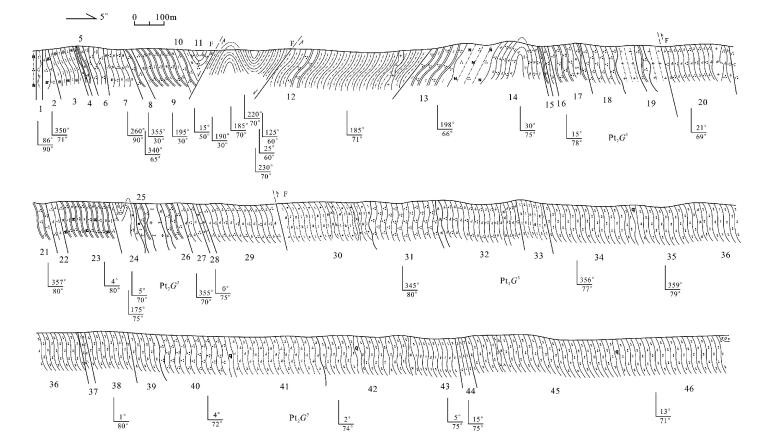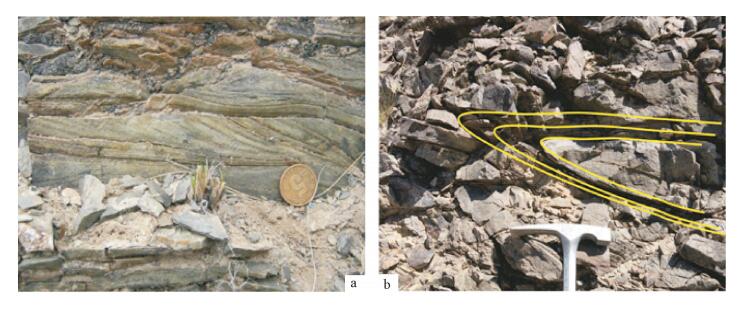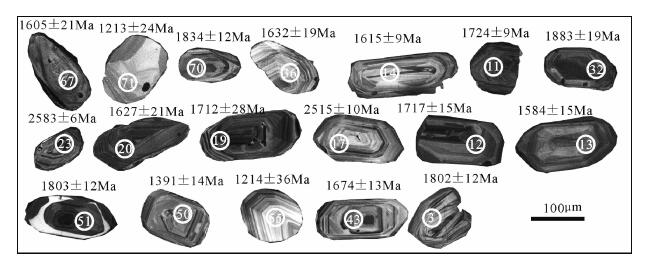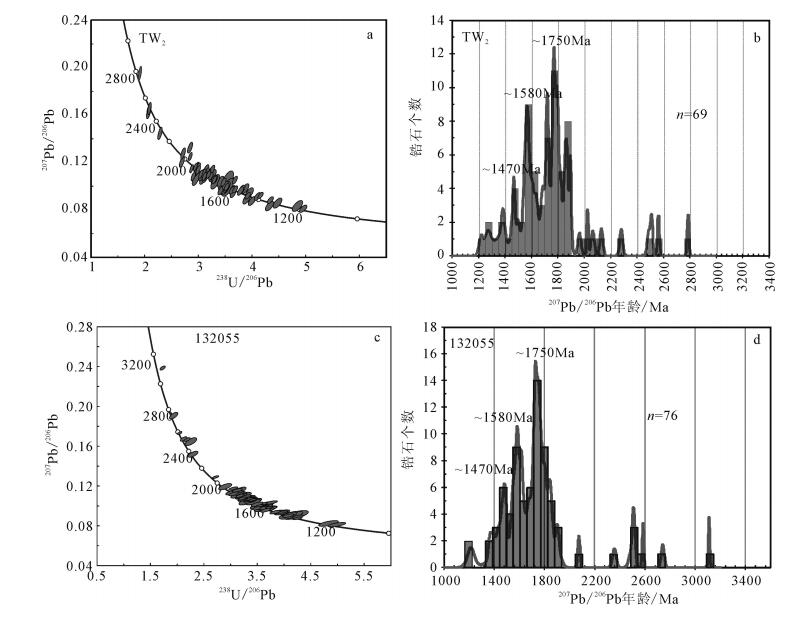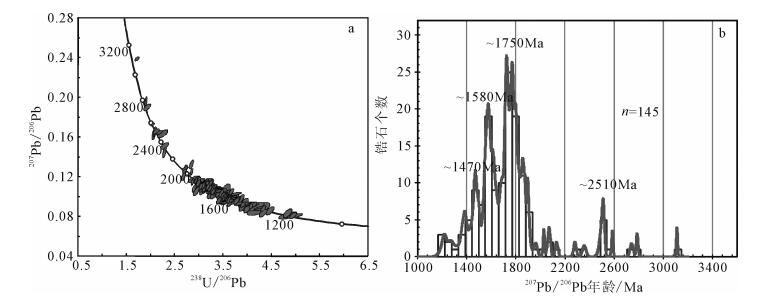Geological characteristics and age determination of the Palaeoproterozoic Gudongjing Group complex in the Beishan Mountain, Gansu Province
-
摘要:
北山地区出露大量古硐井群,其地层时代主要依据区域地层对比和上覆、下伏地层中获得的Sm-Nd全岩等时线年龄确定,没有高精度的年龄数据。为了获得并限定古硐井群的时限,采用LA-ICP-MS和SHRIMP测试方法,对北山地区出露大量古硐井群石英岩中的碎屑锆石进行U-Pb同位素年龄测试,获得最年轻的碎屑锆石年龄为1213±24Ma,可以作为古硐井群的下限年龄(中元古代中晚期)。获得3110±6Ma、2786±7Ma等碎屑锆石年龄,暗示甘蒙北山微地块存在古老的地壳残留,表明古硐井群是北山地区的变质基底之一。连续的3个峰值年龄1750Ma、1580Ma和1470Ma,表明古硐井群石英岩的沉积物大部分来自经历过晋宁运动的源区。研究结果为完善北山地区的地层格架提供了有利依据。
Abstract:There are abundant outcrops of Gudongjing Group in Beishan region without paleontological fossil, therefore its strati-graphic age was previously determined by regional stratigraphic correlation and the Sm-Nd isochron age obtained from the overlying strata and underlying layer, resulting in no precise age for Gudongjing Group. In this study, the authors applied LA-ICP-MS and SHRIMP methods to determine isotopic age of detrital zircon in Gudongjing Group with the purpose of obtaining its age. The youngest age of detrital zircon is 1213±24Ma and it is considered to be the lower age limit. The detrital zircon age of 3110±6Ma and 2786±7Ma may indicate ancient remnants of the Earth's crust in Beishan micro-block, and Gudongjing Group may be one of the metamorphosed basements in Beishan. Three continuous peak ages (1750Ma, 1580Ma and 1470Ma) show that the provenance of most quartzite in Gudongjing Group went through the Luliang movement. Therefore, the results of this study can serve as powerful evidence for completing the stratigraphic framework in Beishan.
-
Keywords:
- detrital zircon /
- Beishan /
- Gudongjing Group /
- LA-ICP-MS /
- SHRIMP
-
甘新蒙北山地区出露大量前寒武纪古老变质岩,被认为是北山地区的变质基底。古硐井群即为其中之一,其原始定义指分布于马鬃山、大红山、豹皮山、古硐井等地的一套紫红色、灰绿色砂岩、千枚岩、板岩、石英岩等,厚3510m,未见下界,其上与圆藻山群整合接触,局部为假整合接触。该群由修泽雷等①在额济纳旗南部的古硐井地区命名,并建立了标准剖面。笔者研究的甘肃牛圈子地区出露的古硐井群,高振家②与甘肃区测二队将其命名为白湖南群。经过多次修改,甘肃省地质矿产局[1]在编写甘肃省岩石地层时最终确定,重新定义古硐井群,同时将白湖南剖面确定为古硐井群的次层型剖面。明确了古硐井群现今的定义:指分布于额济纳旗南部月牙山—古硐井一带,位于古、中元古界间断面之上的一套浅海相的陆源碎屑岩,局部夹灰岩透镜体。陆源碎屑以石英质含量大、粒度细、层理薄、轻微变质、褐红色的风化面等宏观特征为识别标志;区域上以不整合覆于古元古界北山岩群之上;上界与圆藻山群的碳酸盐岩连续沉积。之后开展的1:5万区域地质矿产调查项目③④和许多综合研究[2-6],以及1:25万区域地质调查⑤等均沿用古硐井群。目前仅有少量变质岩同位素年代学数据, 介于1600~1800Ma之间。但是,从层型剖面、次层型剖面、1:25万区域地质调查及1:5万区域地质调查中均未获得可靠的年龄数据。内蒙古岩石地层[7]中古硐井群的时代根据产出的层位及岩石组合特征,并与燕山地区的长城系做了对比,确定为中元古代长城纪,但清晰地表达了古硐井群没有可靠的年龄依据;而甘肃省岩石地层中,根据铅炉子沟群变质玄武岩Sm-Nd全岩等时线年龄值为1622~ 1624Ma,并认为古硐井群与铅炉子沟群在区域上为同期异相沉积,将古硐井群地质年代划归长城纪。对同时具有层型剖面和次层型剖面的古硐井群来说,其精确的同位素年龄数据尤为重要,也是北山构造带构造单元划分的重要依据之一。笔者参加的甘肃北山牛圈子地区6幅区域地质调查(中澳合作填图)项目对白湖南—草呼勒哈德(黑山井)一带开展了详细的野外地质调查与综合研究,采集了2件同位素年龄样品,借助先进的同位素测年技术,进一步确定古硐井群的形成时代,为完善甘蒙北山地区地层格架积累素材。同时,为开展北山地区与东天山、阿尔金、阿拉善地区的区域地层对比研究提供年龄资料,为北山地区构造单元划分提供地层依据。
1. 岩石地层特征
古硐井群属天山造山带中天山-北山地块的褶皱基底,分布于甘肃省马鬃山、大红山、豹皮山及内蒙古额济纳旗古硐井等地区,大地构造位置位于中天山-北山的东段(图 1)。研究区(黑山井一带)古硐井群普遍遭受不同程度的构造置换,韧性剪切变形强烈,原始沉积叠置关系已发生不同程度的改变,构成总体有序、局部无序的构造地层序列,是经过低绿片岩相区域变质作用,后又叠加接触变质作用改造的构造-岩石地层单元;自下而上可划分为3个岩性段:第一岩性段底部与敦煌岩群为断层接触关系;岩性段之间为连续堆叠关系,第三岩性段未见顶,被第四系覆盖。3个岩性段之间以构造片理面接触,总体成层有序[10]。
![]() 1—第四系;2—新近系苦泉组;3—侏罗系水西沟组;4—三叠系二断井组;5—二叠系红岩井组;6—牛圈子混杂岩砂岩岩片;7—蓟县系平头山组第一岩性段;8—古硐井群第三岩性段;9—古硐井群第二岩性段;10—古硐井群第一岩性段;11—中泥盆世二长花岗岩;12—早泥盆世糜棱岩化花岗闪长岩;13—早志留世二长花岗岩;14—基性岩脉;15—地质界线;16—推测界线;17—断层;18—推测断层;19—褶皱;20—灰岩;21—剖面位置;22—年龄样采样点。Ⅰ—哈萨克斯坦板块:Ⅰ-1—东准噶尔早古生代弧盆系;Ⅰ-2—雅满苏石炭纪-二叠纪裂谷;Ⅰ-3—卡瓦布拉克地块;Ⅱ—中天山地块:Ⅱ-1—明水-旱山微板块:Ⅱ-1-1—北山北部石炭纪-二叠纪裂谷;Ⅱ-1-2—双沟山早古生代活动陆缘;Ⅱ-1-3—狐狸山早古生代活动陆缘;Ⅱ-1-4—星星峡-明水-旱山地块;Ⅱ-1-5—芨芨台子-小黄山石炭纪-二叠纪裂谷;Ⅱ-1-6—公婆泉奥陶纪-志留纪陆缘弧;Ⅱ-1-7—破城山新元古代-寒武纪裂陷盆地;Ⅱ-2—红柳河-牛圈子-洗肠井早古生代蛇绿构造混杂岩带;Ⅱ-3—敦煌微陆块:Ⅱ-3-1—方山口-双鹰山-鹰咀红山新元古代-寒武纪裂陷盆地;Ⅱ-3-2—干泉-帐房山-梧铜沟石炭纪-二叠纪裂谷;Ⅱ-3-3—辉铜山-将军台奥陶纪裂谷;Ⅱ-3-4敦煌微地块;Ⅲ—中朝板块:Ⅲ-1—阿拉善微陆块;Ⅳ—祁连山造带:Ⅳ-1—北祁连山早古生代弧盆系Figure 1. The sketch map of regional geology of Heishanjing
1—第四系;2—新近系苦泉组;3—侏罗系水西沟组;4—三叠系二断井组;5—二叠系红岩井组;6—牛圈子混杂岩砂岩岩片;7—蓟县系平头山组第一岩性段;8—古硐井群第三岩性段;9—古硐井群第二岩性段;10—古硐井群第一岩性段;11—中泥盆世二长花岗岩;12—早泥盆世糜棱岩化花岗闪长岩;13—早志留世二长花岗岩;14—基性岩脉;15—地质界线;16—推测界线;17—断层;18—推测断层;19—褶皱;20—灰岩;21—剖面位置;22—年龄样采样点。Ⅰ—哈萨克斯坦板块:Ⅰ-1—东准噶尔早古生代弧盆系;Ⅰ-2—雅满苏石炭纪-二叠纪裂谷;Ⅰ-3—卡瓦布拉克地块;Ⅱ—中天山地块:Ⅱ-1—明水-旱山微板块:Ⅱ-1-1—北山北部石炭纪-二叠纪裂谷;Ⅱ-1-2—双沟山早古生代活动陆缘;Ⅱ-1-3—狐狸山早古生代活动陆缘;Ⅱ-1-4—星星峡-明水-旱山地块;Ⅱ-1-5—芨芨台子-小黄山石炭纪-二叠纪裂谷;Ⅱ-1-6—公婆泉奥陶纪-志留纪陆缘弧;Ⅱ-1-7—破城山新元古代-寒武纪裂陷盆地;Ⅱ-2—红柳河-牛圈子-洗肠井早古生代蛇绿构造混杂岩带;Ⅱ-3—敦煌微陆块:Ⅱ-3-1—方山口-双鹰山-鹰咀红山新元古代-寒武纪裂陷盆地;Ⅱ-3-2—干泉-帐房山-梧铜沟石炭纪-二叠纪裂谷;Ⅱ-3-3—辉铜山-将军台奥陶纪裂谷;Ⅱ-3-4敦煌微地块;Ⅲ—中朝板块:Ⅲ-1—阿拉善微陆块;Ⅳ—祁连山造带:Ⅳ-1—北祁连山早古生代弧盆系Figure 1. The sketch map of regional geology of Heishanjing1.1 实测剖面
为了与层型剖面对比,笔者对该岩群甘肃省马鬃山镇牛圈子地区黑山井一带实测地质剖面(图 2)开展研究。结合剖面图和路线地质调查,可以将古硐井群划分为3个岩性段,与1:25万区域地质调查一致。第一岩性段主要岩石组合为灰白色条带状大理岩与深灰色、灰色中厚层石英岩互层,云母石英片岩、石英片岩夹灰岩透镜体,大量发育顺层掩卧褶皱的石英片岩,为一套海相碳酸盐岩夹陆源碎屑沉积;第二岩性段岩石组合主要为灰色-灰黑色石英砂岩、变砂岩、砂质板岩、绢云千枚岩、云母石英片岩夹薄层灰岩,石英碎屑变少、泥质成分增多,粒度变细,主要为陆源碎屑沉积建造;第三岩性段为浅灰色千枚岩、灰色长石石英砂岩、泥质粉砂岩、石英片岩及大理岩,也为陆源碎屑沉积建造;泥质粉砂岩中发育交错层理(图 3-a),为判断顶底的标志之一。剖面第三岩性段中发育大量辉绿岩脉,以近南北向为主,无明显变质变形。基性岩脉在剖面的其他2个岩性段中不发育,在区域上发育(图 1)。剖面描述如下。
未见顶
古硐井群第三岩性段(Pt2G3)
46.灰色粉砂质片岩 373.7m
45.浅灰色-浅棕红色粉砂质片岩 480.2m
44.深灰色泥质粉砂岩 27.7m
43.浅棕色-灰色粉砂质、泥质片岩 144.6m
42.灰色粉砂质片岩 214.2m
41.灰色绢云母千枚岩 288.9m
40.浅灰色石英片岩 224.2m
39.浅棕色粉砂质片岩 84.3m
38.灰色粉砂质片岩夹少量斑状片岩 140.2m
37.灰色板状含粉砂绢云母千枚岩 3.6m
36.浅棕红色-浅灰色粉砂质片岩 464.2m
35.浅棕红色粉砂质片岩 12.4m
34.浅灰色粉砂质片岩 527.1m
33.板状含粉砂二云母千枚岩 89.4m
32.深灰色绢云母石英片岩 245.8m
31.深灰黑色细粒石英片岩 212.6m
30.灰色板状含砂二云母千枚岩 296.7m
古硐井群第二岩性段(Pt2G2)
29.浅灰绿色绢云母石英片岩 257.6m
28.灰色含细砂中粒晶灰岩 5.5m
27.灰色绢云母石英片岩 51m
26.浅灰色石英岩夹石英片岩 55.8m
25.深灰色中-厚层状石英岩夹绢云母石英片岩 24.3m
24.深灰色绢云母石英片岩夹石英岩 69.1m
23.含白云母长石石英岩 187m
22.深灰色绢云母石英片岩 32.9m
21.浅灰色石英岩夹薄层细砂岩 45.6m
20.深灰色绢云母石英片岩 185.7m
————断层接触————
古硐井群第一岩性段(Pt2G1)
19.灰色石英岩 26.1m
18.灰色石英片岩 117.4m
17.灰色石英岩 101.5m
16.灰色绢云母石英片岩 13.6m
15.灰色含黑云母石英岩 4.6m
14.灰色绢云母石英片岩 25.9m
13.灰色含黑云母石英岩 49.9m
12.灰色浅粒岩 260.4m
11.灰色二云母石英片岩 48.1m
10.深灰色厚层石英岩 17.4m
9.灰色含二云母石英岩 81m
8.深灰色石英岩透镜体 14.6m
7.灰黄色白云母石英片岩 15.8m
6.灰色含石榴子石黑云母石英岩 49.6m
5.灰色含二云母石英岩 8.6m
4.灰色含黑云母石英岩 4.8m
3.深灰色含石榴子石黑云母变粒岩 87.1m
2.灰色糜棱岩化云母长石石英片岩 1.3m
1.浅灰色黑云母变粒岩 1.5m
未见底
1.2 层型剖面
内蒙古自治区岩石地层[7]将额济纳旗南部的古硐井群剖面确定为正层型剖面(剖面列述见内蒙古自治区岩石地层[7],本处略),认为古硐井群为一套浅海相的陆源碎屑岩,局部夹灰岩透镜体。陆源碎屑以石英质含量大、粒度细、层理薄、轻微变质、褐红色的风化面等宏观特征为识别标志;虽然各地厚度有所变化,但其岩性岩相较稳定,加之较浅的变质程度和区域上清晰的上、下界线,易于区别相邻的岩石地层单位。在望旭山一带该群下部主要为变质粉砂岩、粉砂质板岩夹少量灰岩透镜体组成,中上部主要为变质细粒石英砂岩夹变质细粒长石石英砂岩,岩石中普遍含铁,风化面常为褐红色。大王山一带下部为灰色变质细粒长石石英砂岩夹变质粉砂岩,底部为二云斜长角岩、黑云阳起石岩,含少量绢云母、白云母。上部主要为变质砂岩、变质粉砂岩夹数层大理岩,风化面为灰黑色,厚2275m。黑大山、黄山主要为千枚岩、硅质板岩、粉砂质板岩夹结晶灰岩,东三羊井一带为含云母石英岩、板岩、黑云母角岩。
1.3 次层型剖面
甘肃省岩石地层[1]将甘肃省肃北县白湖南剖面定为次层型剖面(剖面描述见1:25万马鬃山幅区域地质调查报告⑤,白湖南次层型剖面修测,本处略)。划分为3个岩性段:一、二岩性段以石英岩、石英片岩、绿泥石英片岩为主,夹黑云片岩、透辉石变粒岩、大理岩;三岩性段为浅褐紫色-灰绿色浅粒岩、杂色绢云千枚岩、砂质板岩夹变粉砂岩、黑云斜长变粒岩、黑云石英片岩、大理岩。具绿片岩相变质,原生面理被置换,原生组构很少保留,三岩组变质轻微,原生面理基本保留,一般由浅粒岩-杂色绢云千枚岩组成韵律层序。
本次开展的实测剖面与内蒙古岩石地层中[7]古硐井群层型剖面岩石组合有相似性,而与甘肃省岩石[1]中次层型剖面岩石组合几乎完全一致,总体反映了构造稳定的碎屑岩陆表海环境。说明将工作区内的该套岩石组合厘定为古硐井群是十分合适的。
2. 同位素样品与分析
2.1 样品采集
笔者共采集2件同位素年龄样品,样品采自甘肃省北山构造带黑山井南古硐井群第一岩性段,岩性为石英岩,样品编号分别为TW2和132055,其中TW2样品为2013年采集;为了进一步验证其结果的可靠性,2014年采集132055样品。样品重量均超过10kg,132055样品呈灰黑色,粒状变晶结构,粒径为0.4~0.1mm,矿物组成为石英为80%~90%、斜长石为5%~10%、黑云母为5%~10%、石榴子石为1%~ 2%及少量帘石(< 1%)、磷灰石(< 1%)、锆石(< 1%)。特征变质矿物有石榴子石,石英,呈粒状变晶结构。其中,斜长石和黑云母常呈条痕状定向分布。在TW2样品中观察到有后期方解石细脉充填于裂隙中。二者原岩均为碎屑沉积岩。
样品中获得的锆石大小不等,粒径为60~ 200μm,多呈浑圆状,遭受强烈的磨蚀; 部分锆石晶形较好,表明该部分碎屑物质源区较近。大部分锆石颗粒以无色、淡棕色为主。阴极发光(CL)图像显示(图 4),大部分锆石具有明显密集的振荡环带,Th/ U值为0.12~2.46,绝大部分大于0.2,表明锆石为岩浆成因;少部分锆石没有明显的振荡环带,少数锆石可见窄的变质增生边,但由于宽度小于激光束斑直径而无法进行分析。
2.2 分析测试条件
锆石单矿物挑选分别在河北省区域地质矿产调查研究所实验室完成和河北省廊坊市尚艺岩矿检测有限公司完成,将岩石样品破碎为20~30目,经常规浮选和磁选方法分选挑出锆石,在显微镜下尽可能挑选形态较完整、裂痕较少或无裂痕、无包裹体的锆石作为测定对象。在西北大学大陆动力学国家重点实验室将分选出的锆石晶体粘在环氧树脂胶上固制成靶,把粘有锆石的一面抛磨至锆石内部充分暴露,然后进行锆石显微(反射光和透射光)照相、阴极发光显微图像研究及LA-ICP-MS锆石微区U-Pb同位素组成测定。
TW2样品,阴极发光和实验测试在西北大学大陆动力学国家重点实验室完成。LA-ICP-MS激光剥蚀采样方式为单点剥蚀。数据分析前用美国国家标准技术研究院研制的人工合成硅酸盐玻璃标准参考物质NIST610进行仪器的最佳化,使仪器达到最大的灵敏度、最小的氧化物产率和最低的背景值。ICP-MS数据采集选用一个质量峰采集一点的跳峰方式,每测定5个样品点,测定一个标准锆石91500和一个NIST610。数据处理采用GLITTER (ver4.0)程序,年龄计算以标准锆石91500为外标进行同位素比值分馏校正;元素浓度计算采用NIST610作外标,Si作内标。锆石谐和图用Isoplot程序获得[8]。详细的仪器设备、分析步骤和数据处理见参考文献[9-10]。
132055样品,阴极发光和实验测试在北京离子探针中心完成。在SHRIMP的测试过程中由标准锆石TEM和SL13分别进行同位素内部分馏校正和U、Th、Pb含量的测定,用204Pb进行普通铅校正。测试全过程严格按规定流程和要求进行,分析程序和数据处理使用Squid2.50和Isoplot3.7[8]。文中的同位素比值误差用1σ表示,年龄加权平均值的置信水平为95%。
2.3 分析结果
古硐井群石英岩2件样品共测试155个U-Pb年龄点,经普通铅校正后,剔除204Pb过高及谐和度较差(谐和度<90和>110)的10个点(包括TW2样品:5、8、17、35、47、52、56、64、77等9个点和132055样品的8号点),有效测试点共145个,TW2样品69个,132055样品76个(表 1)。
表 1 古硐井群石英岩锆石U-Th-Pb同位素数据Table 1. Results of U-Th-Pb isotope analysis of quartzite in the Gudongjing Group分析点号 组成/10-6 232Th/238U 238U/206Pb ±1σ 207Pb/206Pb ±1σ 238U/206Pb ±1σ 207Pb/206Pb ±1σ 同位素年龄/Ma 238U 232Th 238U/206Pb ±1σ 207Pb/206Pb ±1σ 132055-1 152 129 0.87 2.176 0.024 0.16646 0.00080 2.180 0.024 0.16481 0.00090 2434 22 2506 9 132055-2 251 526 2.17 3.615 0.036 0.09776 0.00068 3.615 0.036 0.09760 0.00070 1574 14 1579 13 132055-3 232 116 0.52 3.169 0.032 0.11000 0.00069 3.168 0.032 0.11014 0.00071 1768 16 1802 12 132055-4 117 33 0.29 3.739 0.049 0.09746 0.00094 3.748 0.049 0.09531 0.00125 1524 18 1534 25 132055-5 360 197 0.56 4.243 0.038 0.08731 0.00055 4.244 0.038 0.08719 0.00056 1364 11 1365 12 132055-6 120 34 0.29 3.622 0.047 0.09756 0.00093 3.623 0.048 0.09727 0.00097 1571 18 1572 19 132055-7 99 89 0.92 3.478 0.050 0.09935 0.00103 3.470 0.050 0.10150 0.00135 1633 21 1652 25 132055-9 126 77 0.63 3.228 0.042 0.10712 0.00092 3.228 0.042 0.10712 0.00092 1740 20 1751 16 132055-10 536 281 0.54 3.713 0.029 0.09830 0.00045 3.715 0.029 0.09787 0.00048 1537 11 1584 9 132055-11 413 321 0.80 3.399 0.028 0.10578 0.00051 3.400 0.028 0.10553 0.00053 1662 12 1724 9 132055-12 178 194 1.12 3.220 0.035 0.10599 0.00074 3.223 0.035 0.10514 0.00083 1742 17 1717 15 132055-13 180 130 0.74 3.628 0.039 0.09842 0.00074 3.631 0.039 0.09785 0.00081 1568 15 1584 15 132055-14 422 165 0.40 3.532 0.029 0.09993 0.00046 3.534 0.029 0.09950 0.00049 1606 12 1615 9 132055-15 251 131 0.54 2.706 0.026 0.12879 0.00060 2.708 0.026 0.12817 0.00065 2026 17 2073 9 132055-16 150 106 0.73 3.747 0.042 0.09764 0.00080 3.749 0.042 0.09720 0.00085 1524 16 1571 16 132055-17 122 72 0.61 2.106 0.026 0.16706 0.00093 2.109 0.026 0.16574 0.00103 2502 26 2515 10 132055-18 180 87 0.50 3.403 0.036 0.10586 0.00073 3.406 0.036 0.10519 0.00081 1660 16 1718 14 132055-19 50 20 0.42 3.314 0.060 0.10601 0.00137 3.318 0.060 0.10486 0.00159 1698 28 1712 28 132055-20 97 71 0.75 3.485 0.047 0.10142 0.00097 3.490 0.047 0.10017 0.00116 1624 20 1627 21 132055-21 166 175 1.09 3.644 0.040 0.09542 0.00074 3.641 0.040 0.09599 0.00081 1564 15 1548 16 132055-22 95 96 1.05 3.091 0.041 0.11000 0.00096 3.093 0.041 0.10945 0.00103 1806 21 1790 17 132055-23 378 173 0.47 2.034 0.017 0.17298 0.00064 2.035 0.017 0.17265 0.00065 2577 18 2583 6 132055-24 169 163 1.00 3.824 0.041 0.09351 0.00073 3.827 0.041 0.09292 0.00081 1496 15 1486 16 132055-25 60 18 0.32 1.923 0.032 0.19043 0.00137 1.924 0.032 0.18990 0.00142 2698 37 2741 12 132055-26 202 124 0.63 3.222 0.033 0.10724 0.00069 3.224 0.033 0.10651 0.00076 1741 16 1741 13 132055-27 239 124 0.53 3.206 0.031 0.10722 0.00063 3.205 0.031 0.10746 0.00065 1751 15 1757 11 132055-28 179 157 0.90 4.072 0.043 0.09007 0.00072 4.072 0.043 0.09007 0.00072 1416 14 1427 15 132055-29 282 61 0.22 3.038 0.035 0.11723 0.00070 3.041 0.035 0.11642 0.00077 1833 19 1902 12 132055-30 253 65 0.27 3.188 0.038 0.11215 0.00073 3.192 0.039 0.11105 0.00083 1757 19 1817 14 132055-31 304 206 0.70 1.715 0.020 0.23847 0.00084 1.715 0.020 0.23852 0.00084 2961 28 3110 6 132055-32 153 112 0.76 3.170 0.045 0.11587 0.00117 3.172 0.045 0.11519 0.00123 1766 22 1883 19 132055-33 146 124 0.88 4.096 0.058 0.09118 0.00100 4.094 0.058 0.09151 0.00105 1409 18 1457 22 132055-34 106 58 0.56 3.662 0.060 0.10132 0.00118 3.672 0.060 0.09890 0.00154 1552 23 1603 29 132055-35 202 75 0.39 3.263 0.043 0.10907 0.00082 3.265 0.043 0.10854 0.00088 1722 20 1775 15 132055-36 149 147 1.02 3.560 0.051 0.10097 0.00096 3.562 0.051 0.10042 0.00104 1595 20 1632 19 132055-37 109 84 0.79 3.435 0.055 0.10457 0.00115 3.433 0.055 0.10493 0.00120 1648 24 1713 21 132055-38 325 53 0.17 3.248 0.037 0.10721 0.00064 3.248 0.037 0.10721 0.00064 1730 18 1753 11 132055-39 135 68 0.52 3.955 0.059 0.09336 0.00104 3.961 0.060 0.09195 0.00126 1451 20 1466 26 132055-40 212 123 0.60 3.151 0.040 0.11259 0.00082 3.150 0.040 0.11275 0.00083 1777 20 1844 13 132055-41 43 23 0.55 4.209 0.098 0.09066 0.00185 4.225 0.098 0.08736 0.00266 1369 29 1368 59 132055-42 264 121 0.47 3.112 0.038 0.11545 0.00076 3.118 0.038 0.11364 0.00091 1793 19 1858 14 132055-43 371 68 0.19 3.763 0.043 0.10337 0.00068 3.766 0.043 0.10273 0.00074 1518 16 1674 13 132055-44 50 83 1.73 4.117 0.090 0.09050 0.00166 4.121 0.090 0.08956 0.00191 1400 28 1416 41 132055-45 173 74 0.44 3.363 0.047 0.10484 0.00089 3.367 0.047 0.10376 0.00101 1676 21 1693 18 132055-46 115 83 0.75 3.571 0.057 0.09663 0.00110 3.574 0.057 0.09587 0.00122 1590 23 1545 24 132055-47 223 33 0.15 3.511 0.046 0.09781 0.00083 3.514 0.046 0.09699 0.00093 1614 19 1567 18 132055-48 106 113 1.10 3.281 0.054 0.10433 0.00150 3.288 0.054 0.10234 0.00175 1712 25 1667 32 132055-49 292 123 0.43 3.944 0.046 0.09240 0.00066 3.947 0.046 0.09182 0.00072 1456 15 1464 15 132055-50 435 52 0.12 4.247 0.046 0.08921 0.00058 4.251 0.046 0.08841 0.00065 1362 13 1391 14 132055-51 271 138 0.52 3.200 0.038 0.11063 0.00072 3.201 0.038 0.11023 0.00076 1752 18 1803 12 132055-52 58 68 1.23 2.242 0.045 0.16445 0.00160 2.245 0.045 0.16333 0.00173 2375 41 2490 18 132055-53 101 81 0.82 3.407 0.055 0.10371 0.00116 3.412 0.055 0.10256 0.00134 1657 24 1671 24 132055-54 291 557 1.98 3.876 0.045 0.09398 0.00067 3.881 0.045 0.09269 0.00079 1478 16 1482 16 132055-55 113 63 0.57 4.822 0.075 0.08224 0.00116 4.831 0.075 0.08068 0.00147 1213 18 1214 36 132055-56 149 94 0.66 3.359 0.047 0.10683 0.00095 3.362 0.047 0.10610 0.00104 1679 21 1733 18 132055-57 225 171 0.79 3.111 0.039 0.11343 0.00077 3.113 0.039 0.11285 0.00082 1796 20 1846 13 132055-58 422 420 1.03 3.955 0.042 0.09355 0.00056 3.958 0.042 0.09294 0.00062 1452 14 1487 13 132055-59 81 61 0.78 3.239 0.055 0.11047 0.00126 3.245 0.056 0.10881 0.00151 1732 26 1780 25 132055-60 92 71 0.80 3.316 0.055 0.10748 0.00120 3.317 0.055 0.10708 0.00127 1698 25 1750 22 132055-61 241 109 0.47 3.370 0.041 0.10609 0.00077 3.373 0.041 0.10526 0.00086 1674 18 1719 15 132055-62 141 81 0.59 3.003 0.043 0.11299 0.00096 3.007 0.043 0.11183 0.00109 1851 23 1829 18 132055-63 290 233 0.83 3.707 0.043 0.09604 0.00068 3.708 0.043 0.09574 0.00071 1539 16 1543 14 132055-64 201 104 0.53 3.374 0.044 0.10692 0.00079 3.379 0.044 0.10572 0.00091 1671 20 1727 16 132055-65 136 109 0.83 3.187 0.046 0.10911 0.00096 3.189 0.046 0.10838 0.00105 1758 22 1772 18 132055-66 161 110 0.71 3.574 0.049 0.09926 0.00090 3.576 0.049 0.09878 0.00096 1590 19 1601 18 132055-67 139 119 0.88 3.526 0.050 0.10009 0.00097 3.530 0.051 0.09896 0.00113 1608 21 1605 21 132055-68 101 89 0.92 2.282 0.037 0.15167 0.00125 2.284 0.037 0.15091 0.00132 2341 33 2356 15 132055-69 339 309 0.94 3.679 0.041 0.09978 0.00064 3.681 0.042 0.09929 0.00068 1549 16 1611 13 132055-70 251 150 0.62 3.047 0.037 0.11194 0.00076 3.047 0.037 0.11209 0.00077 1830 20 1834 12 132055-71 174 149 0.89 4.979 0.066 0.08099 0.00091 4.981 0.067 0.08067 0.00097 1179 15 1213 24 132055-72 188 105 0.57 3.263 0.043 0.10765 0.00087 3.267 0.043 0.10643 0.00100 1721 20 1739 17 132055-73 185 220 1.23 3.277 0.044 0.10786 0.00090 3.275 0.044 0.10829 0.00095 1718 20 1771 16 132055-74 94 47 0.51 2.888 0.049 0.11921 0.00126 2.894 0.049 0.11733 0.00152 1913 29 1916 23 132055-75 147 94 0.66 3.365 0.049 0.10637 0.00103 3.363 0.049 0.10696 0.00111 1678 22 1748 19 132055-76 416 582 1.45 3.330 0.037 0.10676 0.00061 3.333 0.037 0.10597 0.00067 1692 17 1731 12 132055-77 170 124 0.76 3.172 0.045 0.10947 0.00097 3.174 0.045 0.10873 0.00106 1765 22 1778 18 TW2-1 198 212 1.07 2.835 0.002 0.13236 0.00189 2.835 0.019 0.13236 0.00189 1948 11 2130 11 TW2-2 142 82 0.58 3.990 0.002 0.08733 0.00157 3.990 0.028 0.08733 0.00157 1442 9 1368 19 TW2-3 190 52 0.27 3.775 0.002 0.09578 0.00144 3.775 0.023 0.09578 0.00144 1515 8 1543 13 TW2-4 136 135 0.99 3.794 0.002 0.09685 0.00160 3.794 0.026 0.09685 0.00160 1508 9 1564 16 TW2-6 368 171 0.46 3.231 0.002 0.11329 0.00143 3.231 0.018 0.11329 0.00143 1738 8 1853 8 TW2-7 539 267 0.49 3.670 0.001 0.10506 0.00131 3.670 0.019 0.10506 0.00131 1554 7 1715 8 TW2-9 108 64 0.59 4.834 0.002 0.08311 0.00186 4.834 0.040 0.08311 0.00186 1212 9 1272 27 TW2-10 199 81 0.41 3.271 0.002 0.10553 0.00139 3.271 0.018 0.10553 0.00139 1720 8 1724 10 TW2-11 293 153 0.52 3.253 0.002 0.11411 0.00144 3.253 0.018 0.11411 0.00144 1728 8 1866 8 TW2-12 225 213 0.95 3.624 0.002 0.09687 0.00144 3.624 0.022 0.09687 0.00144 1571 8 1565 13 TW2-13 270 45 0.17 3.459 0.002 0.10331 0.00144 3.459 0.020 0.10331 0.00144 1637 8 1684 11 TW2-14 95 100 1.05 3.938 0.002 0.09390 0.00189 3.938 0.031 0.09390 0.00189 1459 10 1506 22 TW2-15 138 64 0.46 1.897 0.003 0.19509 0.00246 1.897 0.012 0.19509 0.00246 2729 15 2786 7 TW2-16 306 242 0.79 3.288 0.002 0.10502 0.00129 3.288 0.017 0.10502 0.00129 1712 8 1715 8 TW2-18 163 144 0.89 3.406 0.002 0.09617 0.00147 3.406 0.021 0.09617 0.00147 1660 9 1551 14 TW2-19 613 92 0.15 2.840 0.002 0.12483 0.00143 2.840 0.014 0.12483 0.00143 1944 8 2026 6 TW2-20 217 156 0.72 3.517 0.002 0.09925 0.00135 3.517 0.020 0.09925 0.00135 1613 8 1610 11 TW2-21 213 228 1.07 3.538 0.004 0.09892 0.00305 3.538 0.045 0.09892 0.00305 1605 18 1604 36 TW2-22 391 99 0.25 4.330 0.001 0.08812 0.00117 4.330 0.023 0.08812 0.00117 1339 6 1385 11 TW2-23 35 60 1.73 3.307 0.003 0.10360 0.00250 3.307 0.033 0.10360 0.00250 1703 15 1690 26 TW2-24 18 22 1.25 3.523 0.004 0.10089 0.00353 3.523 0.050 0.10089 0.00353 1611 20 1641 41 TW2-25 114 72 0.63 3.147 0.002 0.10884 0.00166 3.147 0.021 0.10884 0.00166 1779 10 1780 13 TW2-26 287 142 0.49 3.307 0.002 0.10571 0.00133 3.307 0.017 0.10571 0.00133 1703 8 1727 8 TW2-27 131 96 0.73 3.511 0.002 0.09825 0.00153 3.511 0.022 0.09825 0.00153 1616 9 1591 14 TW2-28 197 272 1.38 3.086 0.002 0.11076 0.00146 3.086 0.017 0.11076 0.00146 1809 9 1812 10 TW2-29 110 69 0.62 3.134 0.002 0.11360 0.00178 3.134 0.021 0.11360 0.00178 1785 11 1858 13 TW2-30 210 119 0.57 3.615 0.002 0.09635 0.00133 3.615 0.020 0.09635 0.00133 1574 8 1555 11 TW2-31 79 89 1.12 3.070 0.002 0.10599 0.00189 3.070 0.023 0.10599 0.00189 1818 12 1732 17 TW2-32 193 182 0.94 3.489 0.002 0.10061 0.00141 3.489 0.020 0.10061 0.00141 1625 8 1635 11 TW2-33 341 239 0.70 3.675 0.001 0.09727 0.00124 3.675 0.019 0.09727 0.00124 1551 7 1572 9 TW2-34 374 101 0.27 3.181 0.002 0.10977 0.00131 3.181 0.016 0.10977 0.00131 1762 8 1796 7 TW2-36 116 78 0.67 4.317 0.002 0.08313 0.00163 4.317 0.032 0.08313 0.00163 1343 9 1272 22 TW2-37 93 45 0.48 2.077 0.003 0.16530 0.00218 2.077 0.014 0.16530 0.00218 2534 14 2511 8 TW2-38 195 95 0.49 2.986 0.002 0.11355 0.00150 2.986 0.017 0.11355 0.00150 1862 9 1857 9 TW2-39 103 54 0.53 2.273 0.003 0.14436 0.00211 2.273 0.016 0.14436 0.00211 2350 14 2280 11 TW2-40 231 49 0.21 2.895 0.002 0.10810 0.00148 2.895 0.017 0.10810 0.00148 1912 10 1768 10 TW2-41 78 60 0.77 2.940 0.003 0.10578 0.00220 2.940 0.026 0.10578 0.00220 1887 15 1728 21 TW2-42 241 55 0.23 3.035 0.002 0.11005 0.00139 3.035 0.016 0.11005 0.00139 1836 9 1800 8 TW2-43 340 127 0.37 2.863 0.002 0.11457 0.00138 2.863 0.015 0.11457 0.00138 1931 9 1873 7 TW2-44 48 51 1.05 3.503 0.003 0.09863 0.00226 3.503 0.033 0.09863 0.00226 1619 13 1598 25 TW2-45 190 137 0.72 3.638 0.002 0.09348 0.00136 3.638 0.021 0.09348 0.00136 1566 8 1498 13 TW2-46 87 44 0.51 3.528 0.004 0.10447 0.00339 3.528 0.047 0.10447 0.00339 1609 19 1705 37 TW2-48 184 97 0.53 2.988 0.002 0.11576 0.00160 2.988 0.018 0.11576 0.00160 1861 10 1892 10 TW2-49 173 179 1.03 2.953 0.002 0.11196 0.00153 2.953 0.017 0.11196 0.00153 1880 10 1831 10 TW2-50 182 110 0.60 3.109 0.002 0.10910 0.00153 3.109 0.018 0.10910 0.00153 1798 9 1784 11 TW2-51 76 31 0.41 3.120 0.002 0.10759 0.00188 3.120 0.023 0.10759 0.00188 1792 12 1759 16 TW2-52 123 127 1.03 5.393 0.001 0.09727 0.00142 5.393 0.031 0.09727 0.00142 1097 6 1572 12 TW2-54 801 425 0.53 4.149 0.001 0.09209 0.00112 4.149 0.020 0.09209 0.00112 1392 6 1469 8 TW2-55 349 168 0.48 3.907 0.001 0.09182 0.00119 3.907 0.020 0.09182 0.00119 1469 7 1464 10 TW2-57 180 88 0.49 3.043 0.002 0.10804 0.00151 3.043 0.018 0.10804 0.00151 1832 9 1767 11 TW2-58 458 178 0.39 2.934 0.002 0.11601 0.00136 2.934 0.014 0.11601 0.00136 1890 8 1896 6 TW2-59 379 68 0.18 3.225 0.002 0.10829 0.00134 3.225 0.017 0.10829 0.00134 1741 8 1771 8 TW2-60 61 151 2.46 3.256 0.003 0.10888 0.00212 3.256 0.027 0.10888 0.00212 1726 12 1781 19 TW2-61 143 78 0.54 2.957 0.002 0.11587 0.00178 2.957 0.020 0.11587 0.00178 1878 11 1893 13 TW2-62 245 118 0.48 3.866 0.002 0.09795 0.00169 3.866 0.027 0.09795 0.00169 1483 9 1585 17 TW2-63 149 92 0.62 4.466 0.002 0.08561 0.00177 4.466 0.034 0.08561 0.00177 1303 9 1329 24 TW2-65 61 42 0.69 3.434 0.002 0.10101 0.00205 3.434 0.028 0.10101 0.00205 1648 12 1643 21 TW2-66 102 66 0.65 2.707 0.002 0.12751 0.00191 2.707 0.018 0.12751 0.00191 2027 12 2064 12 TW2-67 176 109 0.62 4.091 0.001 0.09119 0.00141 4.091 0.025 0.09119 0.00141 1410 8 1451 14 TW2-68 61 53 0.88 2.068 0.004 0.16321 0.00265 2.068 0.017 0.16321 0.00265 2542 18 2489 12 TW2-69 209 53 0.25 3.121 0.002 0.10931 0.00166 3.121 0.020 0.10931 0.00166 1792 10 1788 13 TW2-70 99 44 0.44 3.888 0.002 0.08904 0.00172 3.888 0.029 0.08904 0.00172 1475 10 1405 21 TW2-71 67 31 0.46 3.107 0.003 0.10807 0.00221 3.107 0.027 0.10807 0.00221 1799 14 1767 21 TW2-72 107 109 1.02 2.679 0.003 0.12045 0.00189 2.679 0.019 0.12045 0.00189 2045 12 1963 13 TW2-73 250 30 0.12 3.103 0.002 0.10816 0.00147 3.103 0.018 0.10816 0.00147 1801 9 1769 10 TW2-74 90 76 0.84 3.402 0.002 0.10380 0.00187 3.402 0.025 0.10380 0.00187 1661 11 1693 17 TW2-75 140 43 0.30 3.062 0.002 0.11029 0.00162 3.062 0.019 0.11029 0.00162 1822 10 1804 12 TW2-76 242 180 0.75 4.942 0.001 0.08084 0.00128 4.942 0.029 0.08084 0.00128 1188 6 1218 16 TW2-78 157 85 0.54 3.149 0.002 0.11141 0.00160 3.149 0.019 0.11141 0.00160 1778 9 1823 11 锆石中普通铅的含量除个别占一定量的比例外,其他锆石普通铅的含量均小于仪器的检出限。大多数锆石位于238U/206Pb-207Pb/206Pb谐和图的谐和线上或其附近,极个别点远离谐和线(图 5)。分析认为,古硐井群石英岩中存在少量古老碎屑锆石。其中,TW2样品年龄最老的碎屑锆石(15样点)207Pb/ 206Pb年龄为2786±7Ma;在U-Pb谐和图(图 5-a)中,该样点位于谐和线上方且靠近谐和线(谐和度为102%)。大多数锆石位于谐和线上或其附近(图 5-a)。锆石的207Pb/206Pb年龄介于2786~1218Ma之间,对所有碎屑锆石的207Pb/206Pb年龄作频率分布图(图 5-b)。谐和年龄主要集中于1896~1218Ma之间,大多数测点位于谐和线上或其附近,为数据的主体,约占所测数据的87%,峰值年龄为1750Ma,这些锆石大多发育振荡环带结构(图 4),Th/U值较高。其余207Pb/206Pb年龄介于2786~1963Ma之间,仅有8个测试数据,且分布较分散,不是主要的物源区。132055样品中最老的碎屑锆石(31样点)207Pb/206Pb年龄为3110Ma,在U-Pb谐和图(图 5-c)中,该样点位于谐和线上方且靠近谐和线(谐和度为105%)。此外,还有6颗207Pb/206Pb年龄超过2200Ma的锆石,都在谐和线上或其附近。从207Pb/206Pb年龄频率分布图(图 5-d)可以看出,年龄数据主要集中在2073~ 1213Ma之间,测点位于谐和线上或其附近,为数据的主体,约占所测数据的90%,峰值为1750Ma,其余207Pb/206Pb年龄介于2356~2741Ma之间,仅有6个测试数据,且分布较分散,不是主要的物源区。
3. 区域地层对比与环境讨论
从古硐井群层型剖面可以得出[7],从下到上,岩性从片理化发育的细砂岩/粉砂岩-细砂岩/长石石英砂岩与硅质岩互层-石英砂岩,发育大量雨痕,底部夹有硅质岩-钙质页岩,夹大量薄层灰岩;出露总厚度大于2159m(层型剖面的参考剖面总厚度大于3638m)。而次层型剖面(白湖南剖面)[1]中,从下到上岩石组合与层型剖面有所不同,下部主要为石英岩、石英片岩-变粒岩-黑云母片岩-石英岩夹薄层大理岩;上部主要为石英片岩-千枚岩-变砂岩-长石石英砂岩-浅粒岩-变粒岩/片岩夹薄层大理岩,出露总厚度大于3773m。本次研究获得的剖面第一岩性段条带状大理岩与深灰色、灰色中厚层石英岩互层,云母石英片岩、石英片岩夹灰岩透镜体,发育顺层掩卧褶皱;第二岩性段为石英砂岩、变砂岩、砂质板岩、绢云千枚岩,局部夹薄层灰岩,粒度变细,主要为陆源碎屑沉积建造;第三岩性段为浅灰色千枚岩、灰色长石石英砂岩、泥质粉砂岩、石英片岩;泥质粉砂岩中发育交错层理。通过对比,认为本次研究剖面的第一、第二岩性段岩石组合与层型剖面和次层型剖面的下部岩石组合相当;而第三岩性段与层型剖面和次层型剖面的上部岩石组合相似。内蒙古岩石地层中关于古硐井群层型剖面描述中说明该剖面受比例尺、交通条件等的限制,分层粗略,作为层型剖面稍有不足。因此,在北山地区建立了次层型剖面作为补充。本次研究的剖面与古硐井群次层型剖面相邻,岩石组合、变形变质等十分相似,厘定为古硐井群是合适的。
区域上古硐井群呈东西向分布于星星峡、白湖及金塔县鸡心山、铅炉子沟,肃北县金庙沟-减水井-内蒙古额济纳旗南部的古硐井一带,各地岩石组合仅有微弱差异,厚度以草呼勒哈德-白湖南最大,为1000~4000m,向两侧变薄。为一套巨厚的陆缘滨浅海碎屑岩-碳酸盐岩建造,以陆源碎屑岩为主,反映海水较深,部分达大陆斜坡或海底扇,发育重力流沉积层序,具较深海水条件,气候温湿;局部以紫红色和灰紫色石英砂岩、粉砂岩、泥岩为主,显示陆棚浅海风暴层序特点。古硐井群以马鬃山白湖南—古硐井一带为沉积中心,向东砂岩增多,在石板井西南夹大量基性火山岩;向西则多泥岩和碳酸盐岩;向南以巨厚的陆源碎屑岩为主;向北厚度骤减。由此表明,古硐井群总体处于陆棚浅海环境,大部分地区以滨潮坪沉积为主。结合中天山、中祁连地块、柴北缘长城纪沉积建造综合分析,推测北山海槽之海水可能来自秦祁昆-天山古大洋。岩石属低绿片岩相变质,一、二岩性段中兼具韧性和脆性强烈变形,发育顺层掩卧褶皱(图 3-b)和顺层韧性剪切带,为一套褶叠层型非史密斯地层⑤。
4. 年代地层讨论
关于古硐井群的时代问题,内蒙古自治区岩石地层进行了特别说明,古硐井群目前尚未搜集到可靠的年龄资料,迄今未发现叠层石、疑源类分子等化石,其时代只是根据产出的层位及岩石组合特征,与燕山地区的长城系做了对比,将其置于中元古代长城纪[7]。而甘肃省岩石地层[1]是根据北山南带咸水井东南铅炉子沟群变质玄武岩Sm-Nd全岩等时线年龄值(1622~1624Ma)和下伏敦煌岩群斜长角闪岩的Sm-Nd全岩等时线年龄2203Ma共同限定的。直到本次研究之前,古硐井群均没有发表公认的、高精度的SHRIMP或LA-ICP-MS等锆石U-Pb同位素年龄数据。锆石微区U-Pb同位素测年结果表明,本次研究获得1213~3110Ma之间有地质意义的碎屑锆石年龄数据共计145个(表 1)。从表 1可以看出,最年轻的锆石(132055-71)207Pb/206Pb年龄为1213±24Ma,该数据具有较好的谐和性,高的U(174×10-6)、Th(149×10-6)含量及较高的Th/U值(0.86),因此,1213±24Ma可以作为古硐井群的最大沉积年龄。根据全国地层委员会2012年9月编制的中国地层表,同位素年龄时限1000~1200Ma对应的地层时代是中元古代狭带系,对应中国年代地层为待建系。故将古硐井群时代厘定为中元古代中晚期。从数据表可以看出,数据主要集中在1213±24~1916±23Ma之间。锆石谐和年龄频率分布图(图 6-b)表明,主要有4个年龄集中区。峰值年龄分别为2510Ma、1750Ma、1580Ma和1470Ma,说明其物源区主要为中元古代早期,表明古硐井群石英岩的沉积物大部分来自经历过晋宁运动的源区。2500Ma的峰值年龄值说明,少部分物源可能经历过五台运动的源区;3110Ma的数据显示较老的锆石信息。结合北山地区大量的早古生代花岗岩年龄中普遍有中元古代的继承锆石信息(对多个古生代年龄样品数据统计,未发表数据),说明古硐井群应为北山地区古老的变质基底之一。
5. 结论
(1)利用LA-ICP-MS锆石微区U-Pb同位素测年技术, 于甘蒙北山地区黑山井古硐井群石英岩中获得3110±6Ma的碎屑锆石年龄,同时获得2356± 15~2786±7Ma的碎屑锆石年龄,说明甘蒙北山微地块存在古老的地壳残留。碎屑锆石年龄主要集中于1213±24~1916±23Ma之间,在古生代花岗岩中有大量该时段的继承锆石信息,表明古硐井群是北山地区的基底之一。
(2)1213±24Ma为古硐井群中最年轻的碎屑物质,限定了该地层沉积时代的下限是中元古代中晚期。
(3)古硐井群石英岩的碎屑锆石连续3个峰值年龄为1750Ma、1580Ma和1470Ma,表明古硐井群石英岩的沉积物大部分来自经历过晋宁运动的源区。
致谢: 感谢中国地质调查局西安地质调查中心李向民、何世平研究员在文章编写过程中提供的意见与建议,感谢评审专家的宝贵意见。 -
1—第四系;2—新近系苦泉组;3—侏罗系水西沟组;4—三叠系二断井组;5—二叠系红岩井组;6—牛圈子混杂岩砂岩岩片;7—蓟县系平头山组第一岩性段;8—古硐井群第三岩性段;9—古硐井群第二岩性段;10—古硐井群第一岩性段;11—中泥盆世二长花岗岩;12—早泥盆世糜棱岩化花岗闪长岩;13—早志留世二长花岗岩;14—基性岩脉;15—地质界线;16—推测界线;17—断层;18—推测断层;19—褶皱;20—灰岩;21—剖面位置;22—年龄样采样点。Ⅰ—哈萨克斯坦板块:Ⅰ-1—东准噶尔早古生代弧盆系;Ⅰ-2—雅满苏石炭纪-二叠纪裂谷;Ⅰ-3—卡瓦布拉克地块;Ⅱ—中天山地块:Ⅱ-1—明水-旱山微板块:Ⅱ-1-1—北山北部石炭纪-二叠纪裂谷;Ⅱ-1-2—双沟山早古生代活动陆缘;Ⅱ-1-3—狐狸山早古生代活动陆缘;Ⅱ-1-4—星星峡-明水-旱山地块;Ⅱ-1-5—芨芨台子-小黄山石炭纪-二叠纪裂谷;Ⅱ-1-6—公婆泉奥陶纪-志留纪陆缘弧;Ⅱ-1-7—破城山新元古代-寒武纪裂陷盆地;Ⅱ-2—红柳河-牛圈子-洗肠井早古生代蛇绿构造混杂岩带;Ⅱ-3—敦煌微陆块:Ⅱ-3-1—方山口-双鹰山-鹰咀红山新元古代-寒武纪裂陷盆地;Ⅱ-3-2—干泉-帐房山-梧铜沟石炭纪-二叠纪裂谷;Ⅱ-3-3—辉铜山-将军台奥陶纪裂谷;Ⅱ-3-4敦煌微地块;Ⅲ—中朝板块:Ⅲ-1—阿拉善微陆块;Ⅳ—祁连山造带:Ⅳ-1—北祁连山早古生代弧盆系
Figure 1. The sketch map of regional geology of Heishanjing
表 1 古硐井群石英岩锆石U-Th-Pb同位素数据
Table 1 Results of U-Th-Pb isotope analysis of quartzite in the Gudongjing Group
分析点号 组成/10-6 232Th/238U 238U/206Pb ±1σ 207Pb/206Pb ±1σ 238U/206Pb ±1σ 207Pb/206Pb ±1σ 同位素年龄/Ma 238U 232Th 238U/206Pb ±1σ 207Pb/206Pb ±1σ 132055-1 152 129 0.87 2.176 0.024 0.16646 0.00080 2.180 0.024 0.16481 0.00090 2434 22 2506 9 132055-2 251 526 2.17 3.615 0.036 0.09776 0.00068 3.615 0.036 0.09760 0.00070 1574 14 1579 13 132055-3 232 116 0.52 3.169 0.032 0.11000 0.00069 3.168 0.032 0.11014 0.00071 1768 16 1802 12 132055-4 117 33 0.29 3.739 0.049 0.09746 0.00094 3.748 0.049 0.09531 0.00125 1524 18 1534 25 132055-5 360 197 0.56 4.243 0.038 0.08731 0.00055 4.244 0.038 0.08719 0.00056 1364 11 1365 12 132055-6 120 34 0.29 3.622 0.047 0.09756 0.00093 3.623 0.048 0.09727 0.00097 1571 18 1572 19 132055-7 99 89 0.92 3.478 0.050 0.09935 0.00103 3.470 0.050 0.10150 0.00135 1633 21 1652 25 132055-9 126 77 0.63 3.228 0.042 0.10712 0.00092 3.228 0.042 0.10712 0.00092 1740 20 1751 16 132055-10 536 281 0.54 3.713 0.029 0.09830 0.00045 3.715 0.029 0.09787 0.00048 1537 11 1584 9 132055-11 413 321 0.80 3.399 0.028 0.10578 0.00051 3.400 0.028 0.10553 0.00053 1662 12 1724 9 132055-12 178 194 1.12 3.220 0.035 0.10599 0.00074 3.223 0.035 0.10514 0.00083 1742 17 1717 15 132055-13 180 130 0.74 3.628 0.039 0.09842 0.00074 3.631 0.039 0.09785 0.00081 1568 15 1584 15 132055-14 422 165 0.40 3.532 0.029 0.09993 0.00046 3.534 0.029 0.09950 0.00049 1606 12 1615 9 132055-15 251 131 0.54 2.706 0.026 0.12879 0.00060 2.708 0.026 0.12817 0.00065 2026 17 2073 9 132055-16 150 106 0.73 3.747 0.042 0.09764 0.00080 3.749 0.042 0.09720 0.00085 1524 16 1571 16 132055-17 122 72 0.61 2.106 0.026 0.16706 0.00093 2.109 0.026 0.16574 0.00103 2502 26 2515 10 132055-18 180 87 0.50 3.403 0.036 0.10586 0.00073 3.406 0.036 0.10519 0.00081 1660 16 1718 14 132055-19 50 20 0.42 3.314 0.060 0.10601 0.00137 3.318 0.060 0.10486 0.00159 1698 28 1712 28 132055-20 97 71 0.75 3.485 0.047 0.10142 0.00097 3.490 0.047 0.10017 0.00116 1624 20 1627 21 132055-21 166 175 1.09 3.644 0.040 0.09542 0.00074 3.641 0.040 0.09599 0.00081 1564 15 1548 16 132055-22 95 96 1.05 3.091 0.041 0.11000 0.00096 3.093 0.041 0.10945 0.00103 1806 21 1790 17 132055-23 378 173 0.47 2.034 0.017 0.17298 0.00064 2.035 0.017 0.17265 0.00065 2577 18 2583 6 132055-24 169 163 1.00 3.824 0.041 0.09351 0.00073 3.827 0.041 0.09292 0.00081 1496 15 1486 16 132055-25 60 18 0.32 1.923 0.032 0.19043 0.00137 1.924 0.032 0.18990 0.00142 2698 37 2741 12 132055-26 202 124 0.63 3.222 0.033 0.10724 0.00069 3.224 0.033 0.10651 0.00076 1741 16 1741 13 132055-27 239 124 0.53 3.206 0.031 0.10722 0.00063 3.205 0.031 0.10746 0.00065 1751 15 1757 11 132055-28 179 157 0.90 4.072 0.043 0.09007 0.00072 4.072 0.043 0.09007 0.00072 1416 14 1427 15 132055-29 282 61 0.22 3.038 0.035 0.11723 0.00070 3.041 0.035 0.11642 0.00077 1833 19 1902 12 132055-30 253 65 0.27 3.188 0.038 0.11215 0.00073 3.192 0.039 0.11105 0.00083 1757 19 1817 14 132055-31 304 206 0.70 1.715 0.020 0.23847 0.00084 1.715 0.020 0.23852 0.00084 2961 28 3110 6 132055-32 153 112 0.76 3.170 0.045 0.11587 0.00117 3.172 0.045 0.11519 0.00123 1766 22 1883 19 132055-33 146 124 0.88 4.096 0.058 0.09118 0.00100 4.094 0.058 0.09151 0.00105 1409 18 1457 22 132055-34 106 58 0.56 3.662 0.060 0.10132 0.00118 3.672 0.060 0.09890 0.00154 1552 23 1603 29 132055-35 202 75 0.39 3.263 0.043 0.10907 0.00082 3.265 0.043 0.10854 0.00088 1722 20 1775 15 132055-36 149 147 1.02 3.560 0.051 0.10097 0.00096 3.562 0.051 0.10042 0.00104 1595 20 1632 19 132055-37 109 84 0.79 3.435 0.055 0.10457 0.00115 3.433 0.055 0.10493 0.00120 1648 24 1713 21 132055-38 325 53 0.17 3.248 0.037 0.10721 0.00064 3.248 0.037 0.10721 0.00064 1730 18 1753 11 132055-39 135 68 0.52 3.955 0.059 0.09336 0.00104 3.961 0.060 0.09195 0.00126 1451 20 1466 26 132055-40 212 123 0.60 3.151 0.040 0.11259 0.00082 3.150 0.040 0.11275 0.00083 1777 20 1844 13 132055-41 43 23 0.55 4.209 0.098 0.09066 0.00185 4.225 0.098 0.08736 0.00266 1369 29 1368 59 132055-42 264 121 0.47 3.112 0.038 0.11545 0.00076 3.118 0.038 0.11364 0.00091 1793 19 1858 14 132055-43 371 68 0.19 3.763 0.043 0.10337 0.00068 3.766 0.043 0.10273 0.00074 1518 16 1674 13 132055-44 50 83 1.73 4.117 0.090 0.09050 0.00166 4.121 0.090 0.08956 0.00191 1400 28 1416 41 132055-45 173 74 0.44 3.363 0.047 0.10484 0.00089 3.367 0.047 0.10376 0.00101 1676 21 1693 18 132055-46 115 83 0.75 3.571 0.057 0.09663 0.00110 3.574 0.057 0.09587 0.00122 1590 23 1545 24 132055-47 223 33 0.15 3.511 0.046 0.09781 0.00083 3.514 0.046 0.09699 0.00093 1614 19 1567 18 132055-48 106 113 1.10 3.281 0.054 0.10433 0.00150 3.288 0.054 0.10234 0.00175 1712 25 1667 32 132055-49 292 123 0.43 3.944 0.046 0.09240 0.00066 3.947 0.046 0.09182 0.00072 1456 15 1464 15 132055-50 435 52 0.12 4.247 0.046 0.08921 0.00058 4.251 0.046 0.08841 0.00065 1362 13 1391 14 132055-51 271 138 0.52 3.200 0.038 0.11063 0.00072 3.201 0.038 0.11023 0.00076 1752 18 1803 12 132055-52 58 68 1.23 2.242 0.045 0.16445 0.00160 2.245 0.045 0.16333 0.00173 2375 41 2490 18 132055-53 101 81 0.82 3.407 0.055 0.10371 0.00116 3.412 0.055 0.10256 0.00134 1657 24 1671 24 132055-54 291 557 1.98 3.876 0.045 0.09398 0.00067 3.881 0.045 0.09269 0.00079 1478 16 1482 16 132055-55 113 63 0.57 4.822 0.075 0.08224 0.00116 4.831 0.075 0.08068 0.00147 1213 18 1214 36 132055-56 149 94 0.66 3.359 0.047 0.10683 0.00095 3.362 0.047 0.10610 0.00104 1679 21 1733 18 132055-57 225 171 0.79 3.111 0.039 0.11343 0.00077 3.113 0.039 0.11285 0.00082 1796 20 1846 13 132055-58 422 420 1.03 3.955 0.042 0.09355 0.00056 3.958 0.042 0.09294 0.00062 1452 14 1487 13 132055-59 81 61 0.78 3.239 0.055 0.11047 0.00126 3.245 0.056 0.10881 0.00151 1732 26 1780 25 132055-60 92 71 0.80 3.316 0.055 0.10748 0.00120 3.317 0.055 0.10708 0.00127 1698 25 1750 22 132055-61 241 109 0.47 3.370 0.041 0.10609 0.00077 3.373 0.041 0.10526 0.00086 1674 18 1719 15 132055-62 141 81 0.59 3.003 0.043 0.11299 0.00096 3.007 0.043 0.11183 0.00109 1851 23 1829 18 132055-63 290 233 0.83 3.707 0.043 0.09604 0.00068 3.708 0.043 0.09574 0.00071 1539 16 1543 14 132055-64 201 104 0.53 3.374 0.044 0.10692 0.00079 3.379 0.044 0.10572 0.00091 1671 20 1727 16 132055-65 136 109 0.83 3.187 0.046 0.10911 0.00096 3.189 0.046 0.10838 0.00105 1758 22 1772 18 132055-66 161 110 0.71 3.574 0.049 0.09926 0.00090 3.576 0.049 0.09878 0.00096 1590 19 1601 18 132055-67 139 119 0.88 3.526 0.050 0.10009 0.00097 3.530 0.051 0.09896 0.00113 1608 21 1605 21 132055-68 101 89 0.92 2.282 0.037 0.15167 0.00125 2.284 0.037 0.15091 0.00132 2341 33 2356 15 132055-69 339 309 0.94 3.679 0.041 0.09978 0.00064 3.681 0.042 0.09929 0.00068 1549 16 1611 13 132055-70 251 150 0.62 3.047 0.037 0.11194 0.00076 3.047 0.037 0.11209 0.00077 1830 20 1834 12 132055-71 174 149 0.89 4.979 0.066 0.08099 0.00091 4.981 0.067 0.08067 0.00097 1179 15 1213 24 132055-72 188 105 0.57 3.263 0.043 0.10765 0.00087 3.267 0.043 0.10643 0.00100 1721 20 1739 17 132055-73 185 220 1.23 3.277 0.044 0.10786 0.00090 3.275 0.044 0.10829 0.00095 1718 20 1771 16 132055-74 94 47 0.51 2.888 0.049 0.11921 0.00126 2.894 0.049 0.11733 0.00152 1913 29 1916 23 132055-75 147 94 0.66 3.365 0.049 0.10637 0.00103 3.363 0.049 0.10696 0.00111 1678 22 1748 19 132055-76 416 582 1.45 3.330 0.037 0.10676 0.00061 3.333 0.037 0.10597 0.00067 1692 17 1731 12 132055-77 170 124 0.76 3.172 0.045 0.10947 0.00097 3.174 0.045 0.10873 0.00106 1765 22 1778 18 TW2-1 198 212 1.07 2.835 0.002 0.13236 0.00189 2.835 0.019 0.13236 0.00189 1948 11 2130 11 TW2-2 142 82 0.58 3.990 0.002 0.08733 0.00157 3.990 0.028 0.08733 0.00157 1442 9 1368 19 TW2-3 190 52 0.27 3.775 0.002 0.09578 0.00144 3.775 0.023 0.09578 0.00144 1515 8 1543 13 TW2-4 136 135 0.99 3.794 0.002 0.09685 0.00160 3.794 0.026 0.09685 0.00160 1508 9 1564 16 TW2-6 368 171 0.46 3.231 0.002 0.11329 0.00143 3.231 0.018 0.11329 0.00143 1738 8 1853 8 TW2-7 539 267 0.49 3.670 0.001 0.10506 0.00131 3.670 0.019 0.10506 0.00131 1554 7 1715 8 TW2-9 108 64 0.59 4.834 0.002 0.08311 0.00186 4.834 0.040 0.08311 0.00186 1212 9 1272 27 TW2-10 199 81 0.41 3.271 0.002 0.10553 0.00139 3.271 0.018 0.10553 0.00139 1720 8 1724 10 TW2-11 293 153 0.52 3.253 0.002 0.11411 0.00144 3.253 0.018 0.11411 0.00144 1728 8 1866 8 TW2-12 225 213 0.95 3.624 0.002 0.09687 0.00144 3.624 0.022 0.09687 0.00144 1571 8 1565 13 TW2-13 270 45 0.17 3.459 0.002 0.10331 0.00144 3.459 0.020 0.10331 0.00144 1637 8 1684 11 TW2-14 95 100 1.05 3.938 0.002 0.09390 0.00189 3.938 0.031 0.09390 0.00189 1459 10 1506 22 TW2-15 138 64 0.46 1.897 0.003 0.19509 0.00246 1.897 0.012 0.19509 0.00246 2729 15 2786 7 TW2-16 306 242 0.79 3.288 0.002 0.10502 0.00129 3.288 0.017 0.10502 0.00129 1712 8 1715 8 TW2-18 163 144 0.89 3.406 0.002 0.09617 0.00147 3.406 0.021 0.09617 0.00147 1660 9 1551 14 TW2-19 613 92 0.15 2.840 0.002 0.12483 0.00143 2.840 0.014 0.12483 0.00143 1944 8 2026 6 TW2-20 217 156 0.72 3.517 0.002 0.09925 0.00135 3.517 0.020 0.09925 0.00135 1613 8 1610 11 TW2-21 213 228 1.07 3.538 0.004 0.09892 0.00305 3.538 0.045 0.09892 0.00305 1605 18 1604 36 TW2-22 391 99 0.25 4.330 0.001 0.08812 0.00117 4.330 0.023 0.08812 0.00117 1339 6 1385 11 TW2-23 35 60 1.73 3.307 0.003 0.10360 0.00250 3.307 0.033 0.10360 0.00250 1703 15 1690 26 TW2-24 18 22 1.25 3.523 0.004 0.10089 0.00353 3.523 0.050 0.10089 0.00353 1611 20 1641 41 TW2-25 114 72 0.63 3.147 0.002 0.10884 0.00166 3.147 0.021 0.10884 0.00166 1779 10 1780 13 TW2-26 287 142 0.49 3.307 0.002 0.10571 0.00133 3.307 0.017 0.10571 0.00133 1703 8 1727 8 TW2-27 131 96 0.73 3.511 0.002 0.09825 0.00153 3.511 0.022 0.09825 0.00153 1616 9 1591 14 TW2-28 197 272 1.38 3.086 0.002 0.11076 0.00146 3.086 0.017 0.11076 0.00146 1809 9 1812 10 TW2-29 110 69 0.62 3.134 0.002 0.11360 0.00178 3.134 0.021 0.11360 0.00178 1785 11 1858 13 TW2-30 210 119 0.57 3.615 0.002 0.09635 0.00133 3.615 0.020 0.09635 0.00133 1574 8 1555 11 TW2-31 79 89 1.12 3.070 0.002 0.10599 0.00189 3.070 0.023 0.10599 0.00189 1818 12 1732 17 TW2-32 193 182 0.94 3.489 0.002 0.10061 0.00141 3.489 0.020 0.10061 0.00141 1625 8 1635 11 TW2-33 341 239 0.70 3.675 0.001 0.09727 0.00124 3.675 0.019 0.09727 0.00124 1551 7 1572 9 TW2-34 374 101 0.27 3.181 0.002 0.10977 0.00131 3.181 0.016 0.10977 0.00131 1762 8 1796 7 TW2-36 116 78 0.67 4.317 0.002 0.08313 0.00163 4.317 0.032 0.08313 0.00163 1343 9 1272 22 TW2-37 93 45 0.48 2.077 0.003 0.16530 0.00218 2.077 0.014 0.16530 0.00218 2534 14 2511 8 TW2-38 195 95 0.49 2.986 0.002 0.11355 0.00150 2.986 0.017 0.11355 0.00150 1862 9 1857 9 TW2-39 103 54 0.53 2.273 0.003 0.14436 0.00211 2.273 0.016 0.14436 0.00211 2350 14 2280 11 TW2-40 231 49 0.21 2.895 0.002 0.10810 0.00148 2.895 0.017 0.10810 0.00148 1912 10 1768 10 TW2-41 78 60 0.77 2.940 0.003 0.10578 0.00220 2.940 0.026 0.10578 0.00220 1887 15 1728 21 TW2-42 241 55 0.23 3.035 0.002 0.11005 0.00139 3.035 0.016 0.11005 0.00139 1836 9 1800 8 TW2-43 340 127 0.37 2.863 0.002 0.11457 0.00138 2.863 0.015 0.11457 0.00138 1931 9 1873 7 TW2-44 48 51 1.05 3.503 0.003 0.09863 0.00226 3.503 0.033 0.09863 0.00226 1619 13 1598 25 TW2-45 190 137 0.72 3.638 0.002 0.09348 0.00136 3.638 0.021 0.09348 0.00136 1566 8 1498 13 TW2-46 87 44 0.51 3.528 0.004 0.10447 0.00339 3.528 0.047 0.10447 0.00339 1609 19 1705 37 TW2-48 184 97 0.53 2.988 0.002 0.11576 0.00160 2.988 0.018 0.11576 0.00160 1861 10 1892 10 TW2-49 173 179 1.03 2.953 0.002 0.11196 0.00153 2.953 0.017 0.11196 0.00153 1880 10 1831 10 TW2-50 182 110 0.60 3.109 0.002 0.10910 0.00153 3.109 0.018 0.10910 0.00153 1798 9 1784 11 TW2-51 76 31 0.41 3.120 0.002 0.10759 0.00188 3.120 0.023 0.10759 0.00188 1792 12 1759 16 TW2-52 123 127 1.03 5.393 0.001 0.09727 0.00142 5.393 0.031 0.09727 0.00142 1097 6 1572 12 TW2-54 801 425 0.53 4.149 0.001 0.09209 0.00112 4.149 0.020 0.09209 0.00112 1392 6 1469 8 TW2-55 349 168 0.48 3.907 0.001 0.09182 0.00119 3.907 0.020 0.09182 0.00119 1469 7 1464 10 TW2-57 180 88 0.49 3.043 0.002 0.10804 0.00151 3.043 0.018 0.10804 0.00151 1832 9 1767 11 TW2-58 458 178 0.39 2.934 0.002 0.11601 0.00136 2.934 0.014 0.11601 0.00136 1890 8 1896 6 TW2-59 379 68 0.18 3.225 0.002 0.10829 0.00134 3.225 0.017 0.10829 0.00134 1741 8 1771 8 TW2-60 61 151 2.46 3.256 0.003 0.10888 0.00212 3.256 0.027 0.10888 0.00212 1726 12 1781 19 TW2-61 143 78 0.54 2.957 0.002 0.11587 0.00178 2.957 0.020 0.11587 0.00178 1878 11 1893 13 TW2-62 245 118 0.48 3.866 0.002 0.09795 0.00169 3.866 0.027 0.09795 0.00169 1483 9 1585 17 TW2-63 149 92 0.62 4.466 0.002 0.08561 0.00177 4.466 0.034 0.08561 0.00177 1303 9 1329 24 TW2-65 61 42 0.69 3.434 0.002 0.10101 0.00205 3.434 0.028 0.10101 0.00205 1648 12 1643 21 TW2-66 102 66 0.65 2.707 0.002 0.12751 0.00191 2.707 0.018 0.12751 0.00191 2027 12 2064 12 TW2-67 176 109 0.62 4.091 0.001 0.09119 0.00141 4.091 0.025 0.09119 0.00141 1410 8 1451 14 TW2-68 61 53 0.88 2.068 0.004 0.16321 0.00265 2.068 0.017 0.16321 0.00265 2542 18 2489 12 TW2-69 209 53 0.25 3.121 0.002 0.10931 0.00166 3.121 0.020 0.10931 0.00166 1792 10 1788 13 TW2-70 99 44 0.44 3.888 0.002 0.08904 0.00172 3.888 0.029 0.08904 0.00172 1475 10 1405 21 TW2-71 67 31 0.46 3.107 0.003 0.10807 0.00221 3.107 0.027 0.10807 0.00221 1799 14 1767 21 TW2-72 107 109 1.02 2.679 0.003 0.12045 0.00189 2.679 0.019 0.12045 0.00189 2045 12 1963 13 TW2-73 250 30 0.12 3.103 0.002 0.10816 0.00147 3.103 0.018 0.10816 0.00147 1801 9 1769 10 TW2-74 90 76 0.84 3.402 0.002 0.10380 0.00187 3.402 0.025 0.10380 0.00187 1661 11 1693 17 TW2-75 140 43 0.30 3.062 0.002 0.11029 0.00162 3.062 0.019 0.11029 0.00162 1822 10 1804 12 TW2-76 242 180 0.75 4.942 0.001 0.08084 0.00128 4.942 0.029 0.08084 0.00128 1188 6 1218 16 TW2-78 157 85 0.54 3.149 0.002 0.11141 0.00160 3.149 0.019 0.11141 0.00160 1778 9 1823 11 -
甘肃省地质矿产局.甘肃省岩石地层[M].武汉:中国地质大学出版社, 2008. 李俊建, 张锋, 任军平, 等.中蒙边界地区构造单元划分[J].地质通报, 2015, 34(4):636-662. http://dzhtb.cgs.cn/ch/reader/view_abstract.aspx?file_no=20150406&flag=1 王立社, 杨建国, 谢春林, 等.甘肃北山火石山哈尔根头口布花岗岩年代学、地球化学及其地质意义[J].地质学报, 2009, 83(3):377-387. http://industry.wanfangdata.com.cn/yj/Detail/Periodical?id=Periodical_dizhixb200903007 杨合群, 李英, 赵国斌, 等.新疆-甘肃-内蒙古衔接区地层对比及其意义[J].西北地质, 2009, 42(4):60-75. http://www.cnki.com.cn/Article/CJFDTotal-GWQY198802001.htm 刘明强, 龚全胜.甘肃北山勒巴泉变质核杂岩[J].西北地质, 2003, 36(2):30-34. https://www.wenkuxiazai.com/doc/0ffc0f123169a4517723a3d9-2.html 俞伯达.关于甘肃长城纪地层划分的新认识[J].甘肃地质学报, 1997, 6(1):1-15. http://www.cnki.com.cn/Article/CJFDTOTAL-DZLP200502000.htm 内蒙古自治区地质矿产局.内蒙古自治区岩石地层[M].武汉:中国地质大学出版社, 1996. Ludwig K R. Isoplot 3.0-A geochronological toolkit for Micro-soft Excel[J]. Berkeley Geochronology Center, Spec Pub, 2003, 4:1-70. https://www.researchgate.net/publication/284758218_ISOPLOT_30_A_Geochronological_Toolkit_for_Microsoft_Excel_Berkeley_Geochronology_Center_Special_Publication
Gao S, Liu X M, Yuan H L, et al. Analysis of forty-two major and trace elements of USGS and NIST SRM Glasses by LA-ICPMS[J]. Geostand. Newsl., 2002, 22:181-195. https://www.researchgate.net/publication/252188504_Analysis_of_forty-two_major_and_trace_elements_in_USGS_and_NIST_SRM_glasses_by_LA-ICPMS
第五春荣, 孙勇, 袁洪林, 等.河南登封地区嵩山石英岩碎屑锆石U-Pb年代学, Hf同位素组成及其地质意义[J].科学通报, 2008, 53:1923-1934. doi: 10.3321/j.issn:0023-074X.2008.16.009 修泽雷, 赵祥生. 1: 100万玉门幅区域地质调查报告. 西安地质矿产研究所. 1964. 高振家. 甘新交界北山地区震旦纪及下古生代地层综合研究报告. 新疆地矿局. 1966. 刘明强, 张国英, 欧阳剑, 等. 甘肃红泉地区1: 5万K46E014023等5幅区域地质矿产调查报告. 甘肃省地质调查院. 2015. 王满仓, 崔继岗, 赵鹏彬, 等. 甘肃独红山地区1: 5万K46E015024等四幅区域地质矿产调查报告. 陕西省地质调查院. 2014. 龚全胜, 梁明红, 刘明强, 等. 1: 25万马鬃山幅区域地质调查报告. 甘肃省地质调查院. 2001.



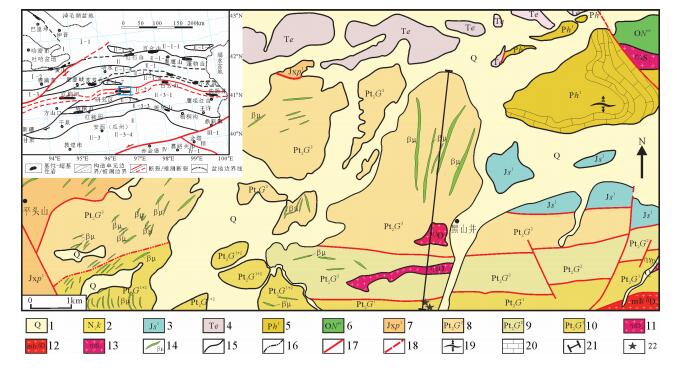
 下载:
下载:
